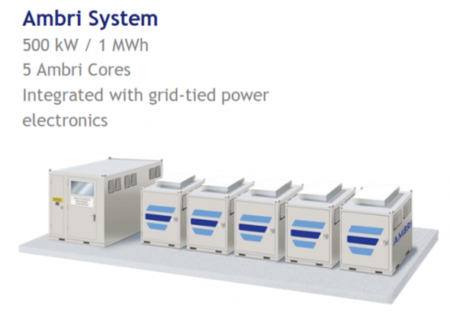A US grid-scale energy storage developer is looking to set up a collaborative research base in Australia, and possibly a manufacturing hub, as it begins to test its liquid metal batteries technology at scale.
The company – which was originally called Liquid Metal Batteries, after the technology, but is now called Ambri – was spun out of the research of Massachusetts Institute of Technology Professor Donald Sadoway, who developed the liquid metal chemistry with his team at MIT.
The batteries, which comprise three self-segregating layers – low density liquid metal on top, high density metal on the bottom, and in the middle molten salt – have yet to be tested at a utility-scale.
They have, however, been tested extensively at a cell and multiple-cell level and found to be highly conductive, fast-responding and long lasting, with very little capacity fade over time, putting them at an advantage over other popular battery chemistries, particularly for grid applications.
There is one “hero cell” at MIT, according to Sadoway, that has been going for two years, and gone through more than 1400 cycles with zero capacity fade.
Essentially, he says, the “upper metal and lower metal (in the batteries) are the electrodes, and the salt is the electrolytes. (These allow) the battery (to) respond very quickly; it can deliver surges and even take surges from the grid.”
Sadoway is in Sydney this week, both to pursue plans to establish a collaborative R&D base at the University of Newcastle and to meet with ARENA.
After being pushed back late last year, development of the first grid-scale LMB prototype, probably 100kWh, is expected to be built in “about a year’s time,” and will be tested at a US army base, possibly Cape Cod, specificallychosen for its proximity to Ambri HQ in Boston.
The first commercial roll-out of the technology is set to be on the Hawaiian island of Kauai, which currently uses diesel generation to back-up its solar PV. “With out battery, their cots of electricity would fall to 27c/kWh on day one,” Sadoway told RE.
But this meeting of the old entrenched generators and the new rise of renewable energy sources like solar and wind are what makes Australia – and “every market,” according to Sadoway – well suited to grid-scale battery storage.
“It’s valuable for the stabilisation of the present day centralised grid, which is very rickety, really, in some cases on the verge of collapse.
“Add to the mix that there’s the environmental imperative these days, and people are moving forward at a fair pace to incorporate renewables.
“My assessment is that … I guarantee you the public is not going to pay one penny premium for unreliable power, even though it’s green. And the only way to make it reliable is to have it storage.”
Image Via: solartown.com
